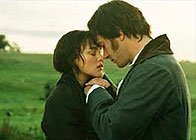|
|
|
|
Pride
and Prejudice
|
 |
|
For some strange reason, costume dramas – especially those based on classic novels – tend to conform to certain limited, set styles and moods. Either they have a stately, ceremonial air, as if paying ritual homage to high culture, or they go to the other extreme and desperately try to revitalise the literary canon with various tricks and turns. The latest version of Jane Austen's Pride and Prejudice, produced by Working Title, falls into the latter group. From our first glimpse of Elizabeth (Keira Knightley), she comes across as a very modern girl. She moves decisively, smiles ironically and bonds with her sisters in a proto-feminist way. Knightley is perhaps a touch too glamorous for the part (Austen's description was more on the order of "quite pretty"), but she certainly carries the film. Her four sisters, including Lydia (Jena Malone) and Jane (Rosamund Pike), are rather pale by comparison. Brenda Blethyn as the worried Mrs Bennet, however, comes screaming out of the blocks at her usual level of fiddly histrionics. Matthew MacFadyen does a decent job at riding the classic role of Mr Darcy from boorishly unattractive snob to darkly romantic object of desire. Some of the best scenes belong to Donald Sutherland as the quiet but firmly principled Mr Bennet. And in a pleasant reminder of the old Quality style, Judi Dench is terrific in the small role of Lady Catherine de Bourg. The task of revitalising a classic seems to oblige contemporary filmmakers to provide some earthiness, some true grit – especially when class differences play a key part in the plot. Pride and Prejudice is more successful than the recent Vanity Fair (2004) in this regard, because it does not overdo the "realistic" views of swilling pigs, broken down carriages and dirty old clothes. Director Joe Wright and screenwriter Deborah Moggach both hail from quality British television, having worked on programs including "Charles II: The Power and the Passion" and "Love in a Cold Climate". Their aim in this adaptation is to keep things upbeat at all costs. If Elizabeth is not spinning on a swing or running down corridors, it is cinematographer Roman Osin's duty to set the brisk pace with a camera that plunges in and out of rooms or races across yards and fields. This contrived energy does not always feel "organic" in relation to the characters and events of Austen's story. Wright's better inventions, however, are reminiscent of what Sofia Coppola did in The Virgin Suicides (2000): the film comes alive when all the Bennet women move as one body in unison, getting out of their chairs in a rush or looking in the same direction at an incoming stranger. You can always tell the tone of a costume piece from the way it stages a ball. Visconti in The Leopard (1963) or Scorsese in The Age of Innocence (1993) pull out all stops, production value-wise, to convey the grandeur and elegance of such an occasion, with perhaps just the hint of a stifling social context. Wright opts for a homely approach, but he still has fun with the contradiction between the set moves of the dance and the private emotions that are bubbling over, particularly within the comically repressed Mr Collins (Tom Hollander). © Adrian Martin October 2005 |
![]()